

Map
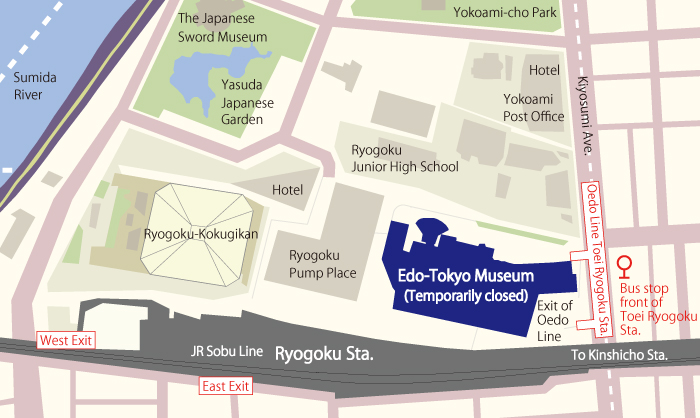
| Address | 1-4-1 Yokoami, Sumida-ku, Tokyo 130-0015 |
|---|---|
| Phone | +81-3-3626-9974 (General Information) |
Getting Here
From Airports
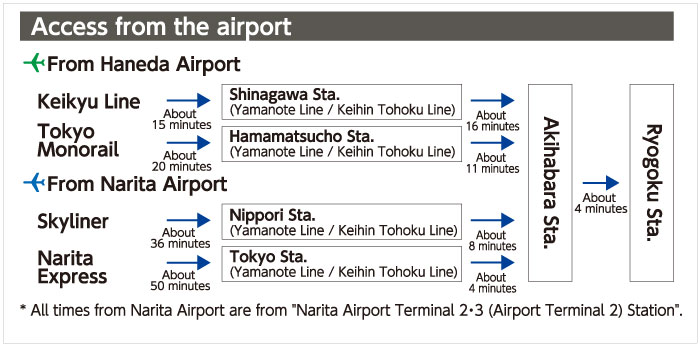
by Train / by Subway
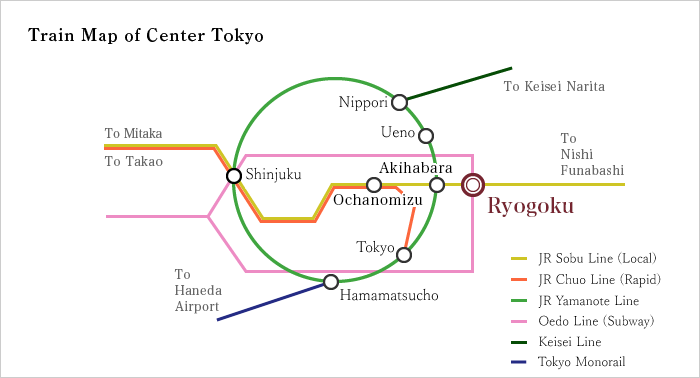
- 3-minute walk from West Exit of Ryogoku Station, JR Sobu Line
- 1-minute walk from A3 or A4 Exit of Ryogoku Station (Edo-Tokyo Hakubutsukan-mae), Toei Subway Oedo Line
by Bus
Toei bus: 錦27, 両28, 門33, 墨38 bus routes
Sumida City circulation bus “Sumida Hyakkei Sumimarukun / Sumirinchan (Southern Route)”
Get off at “Toei Ryogoku Eki-mae (Edo-Tokyo Hakubutsukan-mae)” and walk 3 minutes.
- ※ This stop is different from the “Ryogoku Eki” stop.
By Car
About 10 minutes from the Komagata Exit on Metropolitan Expressway No.6, Mukojima Route, or from the Kinshicho Exit of No.7, Komatsugawa Route.
Parking information
Parking is not available during the museum closure.
Special parking area is reserved for tour buses and cars with disabled persons. Other cars are also allowed in this area when there is much free space.
Coin parking for passenger vehicles is available along Kiyosumi-dori on the eastern side of the museum (100 yen per 15 minutes/capacity 10 vehicles).
Information on Surrounding Area
1.Kokugikan (Sumo Hall)
Watch the dynamic matches of Japan’s traditional grand sumo

The Kokugikan, like the Edo-Tokyo Museum, stands out strikingly on your walk to the Museum from the West Exit of JR Ryogoku Station. Grand sumo tournaments are held at the Kokugikan three times a year in January, May, and September, where matches take place that are full of excitement. The first floor of the Kokugikan houses the Sumo Museum. Nishiki-e woodblock prints, banzuke rankings of sumo wrestlers, kesho-mawashi (apron worn by sumo wrestlers during the ring-entering ceremony), and many more items are exhibited, and visitors can learn about sumo. Exhibitions are changed six times a year. Admission is free on days that events are not held. Here, visitors can appreciate all that is wonderful about Japan’s traditional sport of sumo to their heart’s content.
| Address | 1-3-28 Yokoami, Sumida-ku, Tokyo |
|---|---|
| Access |
|
| Hours | 10:00 - 16:30 |
2.Kyu-Yasuda Teien (Former Yasuda Garden)
A daimyo’s garden that is filled with atmosphere and greenery
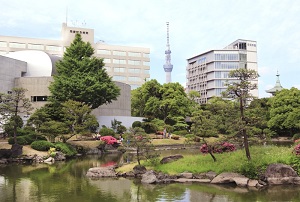
The Kyu-Yasuda Teien was built as a stroll garden with a path by Honjo Munesuke, the feudal lord of the Hitachi-Kasama domain. From 1891, the garden was owned by Yasuda Zenjiro who founded the Yasuda financial group. In the past, one enjoyed changes in the pond’s water level and scenery brought about by the tidal variations of Sumida River. Today, tides are replicated artificially by the creation of an underground reservoir. The landscape, which features a Shinji-ike, or a pond in the shape of the character for “kokoro (heart)” that has small islands and a Yukimi-gata stone lantern, lets visitors enjoy the charms of each season.
| Address | 1-12-1 Yokoami, Sumida-ku, Tokyo |
|---|---|
| Access |
|
| Hours | 9:00 - 16:30 |
3.Sumida River
First-class river that is intertwined with the history of Tokyo
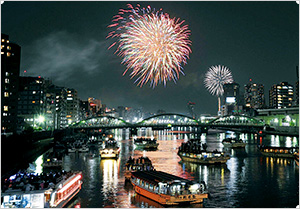
The first-class, 23.5 km-long Sumida River that branches from Arakawa River and flows into Tokyo Bay is intertwined with the history of Edo-Tokyo. Not only has the river been an essential part of the life of the people from ancient times, serving as a transportation route and as a source of water and fish and shellfish, it has also been cherished as a place of relaxation where people cruised on wooden boats called yakatabune, rode on fishing boats, and enjoyed the cherry blossoms and fireworks. A replica of the Ryogoku Bridge that was built over Sumida River is exhibited at the Edo-Tokyo Museum. Compare the current and Edo period views of Sumida River.







